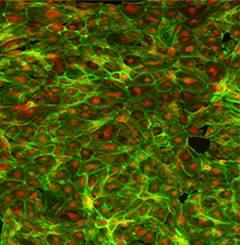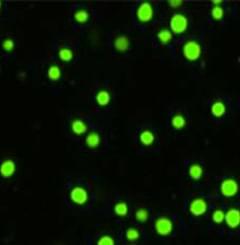- You are here: Home
- Services
- Cell Services
- Cell Line Testing and Assays
- Cell Viability Assays
Services
-
Cell Services
- Cell Line Authentication
- Cell Surface Marker Validation Service
-
Cell Line Testing and Assays
- Toxicology Assay
- Drug-Resistant Cell Models
- Cell Viability Assays
- Cell Proliferation Assays
- Cell Migration Assays
- Soft Agar Colony Formation Assay Service
- SRB Assay
- Cell Apoptosis Assays
- Cell Cycle Assays
- Cell Angiogenesis Assays
- DNA/RNA Extraction
- Custom Cell & Tissue Lysate Service
- Cellular Phosphorylation Assays
- Stability Testing
- Sterility Testing
- Endotoxin Detection and Removal
- Phagocytosis Assays
- Cell-Based Screening and Profiling Services
- 3D-Based Services
- Custom Cell Services
- Cell-based LNP Evaluation
-
Stem Cell Research
- iPSC Generation
- iPSC Characterization
-
iPSC Differentiation
- Neural Stem Cells Differentiation Service from iPSC
- Astrocyte Differentiation Service from iPSC
- Retinal Pigment Epithelium (RPE) Differentiation Service from iPSC
- Cardiomyocyte Differentiation Service from iPSC
- T Cell, NK Cell Differentiation Service from iPSC
- Hepatocyte Differentiation Service from iPSC
- Beta Cell Differentiation Service from iPSC
- Brain Organoid Differentiation Service from iPSC
- Cardiac Organoid Differentiation Service from iPSC
- Kidney Organoid Differentiation Service from iPSC
- GABAnergic Neuron Differentiation Service from iPSC
- Undifferentiated iPSC Detection
- iPSC Gene Editing
- iPSC Expanding Service
- MSC Services
- Stem Cell Assay Development and Screening
- Cell Immortalization
-
ISH/FISH Services
- In Situ Hybridization (ISH) & RNAscope Service
- Fluorescent In Situ Hybridization
- FISH Probe Design, Synthesis and Testing Service
-
FISH Applications
- Multicolor FISH (M-FISH) Analysis
- Chromosome Analysis of ES and iPS Cells
- RNA FISH in Plant Service
- Mouse Model and PDX Analysis (FISH)
- Cell Transplantation Analysis (FISH)
- In Situ Detection of CAR-T Cells & Oncolytic Viruses
- CAR-T/CAR-NK Target Assessment Service (ISH)
- ImmunoFISH Analysis (FISH+IHC)
- Splice Variant Analysis (FISH)
- Telomere Length Analysis (Q-FISH)
- Telomere Length Analysis (qPCR assay)
- FISH Analysis of Microorganisms
- Neoplasms FISH Analysis
- CARD-FISH for Environmental Microorganisms (FISH)
- FISH Quality Control Services
- QuantiGene Plex Assay
- Circulating Tumor Cell (CTC) FISH
- mtRNA Analysis (FISH)
- In Situ Detection of Chemokines/Cytokines
- In Situ Detection of Virus
- Transgene Mapping (FISH)
- Transgene Mapping (Locus Amplification & Sequencing)
- Stable Cell Line Genetic Stability Testing
- Genetic Stability Testing (Locus Amplification & Sequencing + ddPCR)
- Clonality Analysis Service (FISH)
- Karyotyping (G-banded) Service
- Animal Chromosome Analysis (G-banded) Service
- I-FISH Service
- AAV Biodistribution Analysis (RNA ISH)
- Molecular Karyotyping (aCGH)
- Droplet Digital PCR (ddPCR) Service
- Digital ISH Image Quantification and Statistical Analysis
- SCE (Sister Chromatid Exchange) Analysis
- Biosample Services
- Histology Services
- Exosome Research Services
- In Vitro DMPK Services
-
In Vivo DMPK Services
- Pharmacokinetic and Toxicokinetic
- PK/PD Biomarker Analysis
- Bioavailability and Bioequivalence
- Bioanalytical Package
- Metabolite Profiling and Identification
- In Vivo Toxicity Study
- Mass Balance, Excretion and Expired Air Collection
- Administration Routes and Biofluid Sampling
- Quantitative Tissue Distribution
- Target Tissue Exposure
- In Vivo Blood-Brain-Barrier Assay
- Drug Toxicity Services
Cell Viability Assays

Cell viability analyses are crucial for evaluation of cell health and compound toxicity. Cell viability is measured by determining the number of living and dead cells in a total cell sample. An increase in cell viability is accompanied by cell growth, while a decrease in cell viability can indicate the toxic effects of compounds or suboptimal culture conditions. Creative Bioarray offers a wide selection of cell viability assays for drug screening and cytotoxicity tests of chemicals.
Cell viability can be detected based on many different parameters: the redox potential of the cell population, the integrity of cell membranes, or the activity of cellular enzymes such as esterases. Each assay provides a different snapshot of cell health, and can individually or together form the basis of an assay for cell viability, cytotoxicity, or drug efficacy with several integrated components.
Creative Bioarray is capable of providing various options for cell viability assays and compound profiling service based on cell viability:
- MTT/MST/WST-8/WST-1/CKK-8 assays
- Trypan blue assays
- Calcein-AM assays
- Fluorescent reactive dye assays
- Single/Two color viability assays
- Microplate cell viability assays
Features
- Sensitive and accurate result
- Bright fluorescence signal
- High-throughput compound screenings
- Time-efficient
- Flexible options based on the customer’s requirements
Viability measurements can be used for many applications. First of all, determining the viability of cultured cells in an essential process prior to any cell-based study, only a healthy culture will show reliable and reproducible results. By using cell viability assays, researchers can look at the effect of pharmacological compounds on cells, and optimize cell culture conditions or ensure optimal conditions of cells before starting experiments. In addition, it may also be used to evaluate the death or life of cancerous cells and the rejection of implanted organs. In other applications, these tests might calculate the effectiveness of a pesticide or insecticide, or evaluate environmental damage due to toxins.
Example Result

Figure a. Two-color viability assays

Figure b. Single viability assays
Quotations and Ordering
Our customer service representatives are available 24hr a day! We thank you for choosing Creative Bioarray services!
Explore Other Options
For research use only. Not for any other purpose.

